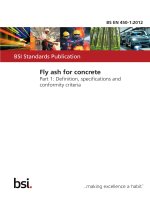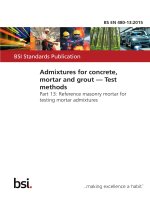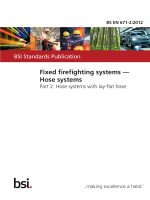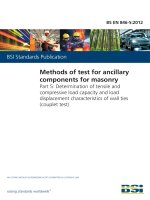Bsi bs en 61788 13 2012
Bạn đang xem bản rút gọn của tài liệu. Xem và tải ngay bản đầy đủ của tài liệu tại đây (1.31 MB, 28 trang )
BS EN 61788-13:2012
BSI Standards Publication
Superconductivity
Part 13: AC loss measurements —
Magnetometer methods for
hysteresis loss in superconducting
multifilamentary composites
BRITISH STANDARD
BS EN 61788-13:2012
National foreword
This British Standard is the UK implementation of EN 61788-13:2012. It is
identical to IEC 61788-13:2012. It supersedes BS EN 61788-13:2003 which is
withdrawn.
The UK participation in its preparation was entrusted to Technical Committee
L/-/90, Super Conductivity.
A list of organizations represented on this committee can be obtained on
request to its secretary.
This publication does not purport to include all the necessary provisions of a
contract. Users are responsible for its correct application.
© The British Standards Institution 2012
Published by BSI Standards Limited 2012
ISBN 978 0 580 75539 2
ICS 17.220; 29.050
Compliance with a British Standard cannot confer immunity from
legal obligations.
This British Standard was published under the authority of the Standards
Policy and Strategy Committee on 30 November 2012.
Amendments issued since publication
Amd. No.
Date
Text affected
BS EN 61788-13:2012
EUROPEAN STANDARD
EN 61788-13
NORME EUROPÉENNE
October 2012
EUROPÄISCHE NORM
ICS 17.220; 29.050
Supersedes EN 61788-13:2003
English version
Superconductivity Part 13: AC loss measurements Magnetometer methods for hysteresis loss in superconducting
multifilamentary composites
(IEC 61788-13:2012)
Supraconductivité Partie 13: Mesure des pertes
en courant alternatif Méthodes de mesure par magnétomètre
des pertes par hystérésis dans les
composites multifilamentaires
supraconducteurs
(CEI 61788-13:2012)
Supraleitfähigkeit Teil 13: Messung der
Wechselstromverluste Magnetometerverfahren zur Messung
der Hystereseverluste von supraleitenden
Multifilament-Verbundleitern
(IEC 61788-13:2012)
This European Standard was approved by CENELEC on 2012-08-29. CENELEC members are bound to comply
with the CEN/CENELEC Internal Regulations which stipulate the conditions for giving this European Standard
the status of a national standard without any alteration.
Up-to-date lists and bibliographical references concerning such national standards may be obtained on
application to the CEN-CENELEC Management Centre or to any CENELEC member.
This European Standard exists in three official versions (English, French, German). A version in any other
language made by translation under the responsibility of a CENELEC member into its own language and notified
to the CEN-CENELEC Management Centre has the same status as the official versions.
CENELEC members are the national electrotechnical committees of Austria, Belgium, Bulgaria, Croatia, Cyprus,
the Czech Republic, Denmark, Estonia, Finland, Former Yugoslav Republic of Macedonia, France, Germany,
Greece, Hungary, Iceland, Ireland, Italy, Latvia, Lithuania, Luxembourg, Malta, the Netherlands, Norway, Poland,
Portugal, Romania, Slovakia, Slovenia, Spain, Sweden, Switzerland, Turkey and the United Kingdom.
CENELEC
European Committee for Electrotechnical Standardization
Comité Européen de Normalisation Electrotechnique
Europäisches Komitee für Elektrotechnische Normung
Management Centre: Avenue Marnix 17, B - 1000 Brussels
© 2012 CENELEC -
All rights of exploitation in any form and by any means reserved worldwide for CENELEC members.
Ref. No. EN 61788-13:2012 E
BS EN 61788-13:2012
EN 61788-13:2012
-2-
Foreword
The text of document 90/302/FDIS, future edition 2 of IEC 61788-13, prepared by IEC/TC 90
"Superconductivity" was submitted to the IEC-CENELEC parallel vote and approved by CENELEC as
EN 61788-13:2012.
The following dates are fixed:
•
latest date by which the document has
to be implemented at national level by
publication of an identical national
standard or by endorsement
(dop)
2013-05-29
•
latest date by which the national
standards conflicting with the
document have to be withdrawn
(dow)
2015-08-29
This document supersedes EN 61788-13:2003.
EN 61788-13:2012 includes
EN 61788-13:2003:
the
following
significant
technical
changes
with
respect
to
-
to extend to the measurement of superconductors in general, in various sample sizes and shapes,
and at temperatures other than 4,2 K;
-
to use the word “uncertainty” for all quantitative (associated with a number) statistical expressions
and eliminate the quantitative use of “precision” and “accuracy” in accordance with the decision at
the June 2006 IEC/TC 90 meeting in Kyoto.
Attention is drawn to the possibility that some of the elements of this document may be the subject of
patent rights. CENELEC [and/or CEN] shall not be held responsible for identifying any or all such
patent rights.
Endorsement notice
The text of the International Standard IEC 61788-13:2012 was approved by CENELEC as a European
Standard without any modification.
BS EN 61788-13:2012
EN 61788-13:2012
-3-
Annex ZA
(normative)
Normative references to international publications
with their corresponding European publications
The following documents, in whole or in part, are normatively referenced in this document and are
indispensable for its application. For dated references, only the edition cited applies. For undated
references, the latest edition of the referenced document (including any amendments) applies.
NOTE When an international publication has been modified by common modifications, indicated by (mod), the relevant EN/HD
applies.
Publication
Year
IEC 60050
IEC 61788-5
Title
EN/HD
Year
Series International Electrotechnical Vocabulary
(IEV)
-
-
-
EN 61788-5
-
Superconductivity Part 5: Matrix to superconductor volume
ratio measurement - Copper
to superconductor volume ratio
of Cu/Nb-Ti composite superconductors
–2–
BS EN 61788-13:2012
61788-13 © IEC:2012
CONTENTS
INTRODUCTION ..................................................................................................................... 5
1
Scope ............................................................................................................................... 6
2
Normative references ....................................................................................................... 6
3
Terms and definitions ....................................................................................................... 6
4
General specifications ...................................................................................................... 8
5
4.1 Target uncertainty ................................................................................................... 8
4.2 Uncertainty and uniformity of the applied field ......................................................... 8
4.3 VSM calibration ....................................................................................................... 8
4.4 Temperature ............................................................................................................ 9
4.5 Specimen length ...................................................................................................... 9
4.6 Specimen orientation and demagnetization effects .................................................. 9
4.7 Normalization volume .............................................................................................. 9
4.8 Mode of field cycling or sweeping ............................................................................ 9
The VSM method of measurement .................................................................................. 10
5.1
5.2
5.3
5.4
6
General ................................................................................................................. 10
VSM measurement principle .................................................................................. 10
VSM specimen preparation .................................................................................... 10
VSM measurement conditions and calibration ....................................................... 12
5.4.1 Field amplitude .......................................................................................... 12
5.4.2 Direction of applied field ............................................................................ 12
5.4.3 Rate of change of the applied field (sweep rate) ........................................ 12
5.4.4 Waveform of the field change .................................................................... 12
5.4.5 Specimen size and shape correction .......................................................... 12
5.4.6 Allowance for addendum (background subtraction) .................................... 13
5.4.7 Data point density ...................................................................................... 13
Test report ...................................................................................................................... 13
6.1
6.2
6.3
Annex A
General ................................................................................................................. 13
Initiation of the test ................................................................................................ 13
Technical details ................................................................................................... 13
(informative) The SQUID method of measurement ................................................. 15
Annex B (normative) Extension of the standard to the measurement of
superconductors in general ................................................................................................... 16
Annex C (informative) Uncertainty considerations ................................................................ 18
Bibliography .......................................................................................................................... 23
Figure 1 – A typical experimental setup of VSM measurement .............................................. 11
Figure 2 – Three alternative specimen configurations for the VSM measurement .................. 11
Table C.1 – Output signals from two nominally identical extensometers ................................ 19
Table C.2 – Mean values of two output signals ..................................................................... 19
Table C.3 – Experimental standard deviations of two output signals ..................................... 19
Table C.4 – Standard uncertainties of two output signals ...................................................... 20
Table C.5 – Coefficient of variations of two output signals .................................................... 20
BS EN 61788-13:2012
61788-13 © IEC:2012
–5–
INTRODUCTION
IEC Technical Committee 90 proposes magnetometer and pickup coil methods for measuring
the AC losses of Cu/Nb-Ti composite superconducting wires in transverse time-varying
magnetic fields. These represent initial steps in standardization of methods for measuring the
various contributions to AC loss in transverse fields, the most frequently encountered
configuration.
It was decided to split the initial proposal mentioned above into two documents covering two
standard methods. One of them describes the magnetometer method for hysteresis loss and
low frequency (or sweep rate) total AC loss measurement in a slowly varying magnetic field,
and the other describes the pickup coil method for total AC loss measurement in higher
frequency (or sweep rate) magnetic fields. The frequency range is 0 Hz – 0,06 Hz for the
magnetometer method and 0,005 Hz – 60 Hz for the pickup-coil method. The overlap between
0,005 Hz and 0,06 Hz is a complementary frequency range for the two methods.
This standard deals with the magnetometer method.
–6–
BS EN 61788-13:2012
61788-13 © IEC:2012
SUPERCONDUCTIVITY –
Part 13: AC loss measurements –
Magnetometer methods for hysteresis loss
in superconducting multifilamentary composites
1
Scope
This part of IEC 61788 describes considerations for the measurement of hysteretic loss in
Cu/Nb-Ti multifilamentary composites using DC- or low-ramp-rate magnetometry. This
international standard specifies a method of the measurement of hysteretic loss in
multifilamentary Cu/Nb-Ti composite conductors. Measurements are assumed to be on round
wires with temperatures at or near 4,2 K. DC or low-ramp-rate magnetometry will be
performed using either a superconducting quantum interference device (SQUID
magnetometer, See Annex A.) or a vibrating-sample magnetometer (VSM). In case
differences between the calibrated magnetometer results are noted, the VSM results,
extrapolated to zero ramp rate, will be taken as definitive. Extension to the measurement of
superconductors in general is given in Annex B.
2
Normative references
The following documents, in whole or in part, are normatively referenced in this document and
are indispensable for its application. For dated references, only the edition cited applies. For
undated references, the latest edition of the referenced document (including any
amendments) applies.
IEC 60050
(all
parts),
International
<)
Electrotechnical
Vocabulary
(available
at
IEC 61788-5, Superconductivity – Part 5: Matrix to superconductor volume ratio measurement
– Copper to superconductor volume ratio of Cu/Nb-Ti composite superconductors
3
Terms and definitions
For the purposes of this part of IEC 61788, the terms and definitions given in IEC 60050-815,
together with the following terms and definitions, apply.
3.1
AC loss
P
power dissipated in a composite superconductor due to application of a time-varying magnetic
field or electric current
Note 1 to entry: The AC loss per magnetic field cycle is designated Q. Although all such loss is inevitably
"hysteretic" in the general sense, the AC loss in a superconducting composite is assumed to be separable into
"hysteresis-", "eddy-current-", and "coupling-" loss components, as defined below (see Note 1 and Note 2 of
IEC 60050-815:2000, 815-04-54).
[SOURCE: IEC 60050-815:2000, 815-04-54, modified – The original two notes have been
replaced by a new note to entry.]
BS EN 61788-13:2012
61788-13 © IEC:2012
–7–
3.2
hysteresis loss
Ph
loss of the type whose value per cycle is independent of frequency arising in a superconductor under a varying magnetic field
Note 1 to entry: This loss is caused by the irreversible magnetic properties of the superconducting material due to
pinning of flux lines.
Note 2 to entry: Hysteresis loss is that which takes place only within the superconducting regions of the Cu/Nb-Ti
composite, and hence which would be present even in the absence of the matrix. The hysteresis loss per cycle,
designated Q h , is associated with the area of the magnetization vs. field (M-H) hysteresis loop; the associated M is
occasionally referred to as the "persistent-current magnetization".
[SOURCE: IEC 60050-815:2000, 815-04-55, modified – A new note to entry has been added.]
3.3
eddy current loss
Pe
loss arising in the normal matrix of a superconductor or the structural material when exposed
to a varying magnetic field, either from an applied field or from a self-field
Note 1 to entry: The eddy current loss per cycle is designated Q e .
[SOURCE: IEC 60050-815:2000, 815-04-56, modified – A new note to entry has been added. ]
3.4
coupling loss
Pc
loss arising in multi-filamentary superconducting wires with a normal matrix due to coupling
current
Note 1 to entry: The coupling loss per cycle is designated Q c.
[SOURCE: IEC 60050-815:2000, 815-04-59, modified – A new note to entry has been added. ]
3.5
proximity effect coupling loss
P pe
loss stemming from currents that circulate along the filaments of a superconducting composite
and across the intervening matrix rendered superconducting by proximity effect (PE)
Note 1 to entry: By so doing, the PE currents compete for the same paths as the coupling currents. Since the PE
entire current path is superconductive, P pe is a persistent-current effect and when it is present serves to augment
P h. Proximity effect can be expected in Cu/NbTi composites when the interfilamentary spacing drops below about
1 µm. The PE loss per cycle is designated Q pe .
3.6
demagnetization
phenomenon in which the specimen’s magnetization reduces the applied magnetic field
sensed by the superconductor
Note 1 to entry: It depends on the strength of that magnetization as well as sample geometry and applied field
orientation. It is usually negligible for multifilamentary Cu/Nb-Ti composites at 4,2 K in large magnetic fields.
3.7
flux creep
thermally activated flux motion in which fluxons move from one pinning centre to another
Note 1 to entry: Flux creep refers to the logarithmic time dependence of decay (at fixed applied field strength and
sample temperature) of a superconductor's persistent-current magnetization. A significant level of flux creep will
–8–
BS EN 61788-13:2012
61788-13 © IEC:2012
contribute a frequency dependence to the hysteretic loss. The effect is negligible for Cu/Nb-Ti composites, except
when proximity effect coupling is present.
[SOURCE: IEC 60050-815:2000, 815-03-20, modified – The original note has been replaced
by a new note to entry.]
3.8
flux jump
cooperative and transitional movements of pinned fluxons as a result of a magnetic instability
initiated by mechanical, thermal, or electrical disturbances
Note 1 to entry: A flux jump manifests itself as a sudden drop in magnetization of the superconductor.
3.9
filamentary volume
total volume of the filaments within a given sample
3.10
composite volume
total specimen volume including both superconductor and matrix
3.11
sweep amplitude
H max
maximum value of the applied field
3.12
magnetization loop
trace of specimen magnetization as function of applied magnetic field strength as the field is
varied around a complete cycle starting and ending at +H max
Note 1 to entry: The area of the loop, Q, is the "energy loss per cycle". As indicated above, by analogy with the
components of power dissipation, Q can be regarded as having the components Q h , Q e , Q c , and Q pe .
4
4.1
General specifications
Target uncertainty
The target uncertainty of this method is defined as coefficient of variation (COV; standard
deviation divided by the average). The COV shall not exceed 5 %.
Important variables and elements affecting the uncertainty of the results are specified as
follows. Introduction to the uncertainty is given in Annex C.
4.2
Uncertainty and uniformity of the applied field
An applied magnetic field system shall provide the magnetic field with a relative standard
uncertainty not to exceed 0,5 %. The applied field shall have a uniformity of 0,1 % over the
volume of the specimen.
4.3
VSM calibration
The goal of VSM calibration is to ensure that the specimen's moment is measured with a
relative combined standard uncertainty not to exceed 1 %. Calibration shall be performed with
all cryostats and any other metal parts in place (as they would be in an actual measurement).
The magnetometer shall be calibrated using a small Ni sphere whose calibration is traceable
to the National Institute of Standards and Technology (N.I.S.T., U.S.A.)’s standard reference
material 772a. This is a Ni sphere 2,383 mm in diameter prepared from high purity Ni wire.
BS EN 61788-13:2012
61788-13 © IEC:2012
–9–
The certified value of its magnetic moment, m, is (3,47 ± 0,01) mA m 2 at 298 K, in a field, H,
of 398 kA/m (µ0 H = 0,5 T). In calibration against this sphere, field and temperature corrections
are made according to
m = 3,47 [1 + 0,0026 ln(H/398)][1 – 0,00047(T−298)]
(mA m 2 )
with H in kA/m (1 kA/m = 12,56 Oe) and T in K. For convenience, a calibration field of about
400 kA/m is recommended.
4.4
Temperature
Measurements shall be made at or near 4,2 K, the normal boiling point of liquid helium and
the actual temperature of measurement reported to a combined standard uncertainty not
exceeding 0,05 K.
At temperatures other than 4,2 K, the temperature shall be known with a relative standard
uncertainty not exceeding 1,2 %, which corresponds to the above combined standard
uncertainty at 4,2 K.
4.5
Specimen length
Several magnetization components are functions of specimen length, L. Length dependence
needs to be eliminated or appropriately allowed for.
a) In relatively short samples, critical current density anisotropy in the longitudinal and
transverse directions will lead to a measurable "end effect" and hence to a length
dependence in Q h . To avert this possibility, specimens shall be prepared whose
superconducting components (filaments) have a length/diameter ratio of more than 20.
b) Proximity effect can be expected to be present in Cu/Nb-Ti multifilamentary composites
only if the filament spacing, d s , is less than about 1 µm. Under this condition, the resulting
PE contribution to magnetization will depend on sample length, L, and twist pitch, L p .
Under this condition, these lengths will need to be taken into account in the following way
when reporting the results:
4.6
–
for d s < about 1 µm and the filaments are untwisted, Q h shall be measured as function
of L and the results extrapolated to zero L;
–
for d s < about 1 µm and the filaments are twisted, Q h shall be measured at L > 5 L p .
Specimen orientation and demagnetization effects
Loss measurements shall be made on strand specimens in a transverse magnetic field. For
the fully penetrated fine filaments of a multifilamentary Cu/Nb-Ti strand, demagnetization is
negligible. By the same token, it is negligible for round-, flat-, or square-cross-sectioned
bundles of such strands. However, for the sake of completeness in reporting the results, the
specimen configuration shall be reported.
4.7
Normalization volume
It may be desirable to report hysteretic loss in terms of the superconductor volume. To pursue
this route, it is necessary to invoke a standard procedure for determining the matrix
(Cu)/superconductor volume ratio (see IEC 61788-5). For the purposes of this standard, these
steps are eliminated, and AC loss is to be reported in terms of total composite volume.
Volume should be measured with a relative combined standard uncertainty not to exceed
0,5 %.
4.8
Mode of field cycling or sweeping
The applied field may be changed point-by-point over the field cycle starting and ending at
H max . SQUID magnetometry is restricted to this mode of field change, and it is optional for the
VSM to be operated in point-by-point mode. The VSM may also be operated semicontinuously,
the M-H loop being constructed from 200 or so (M,H) data-pairs.
– 10 –
5
5.1
BS EN 61788-13:2012
61788-13 © IEC:2012
The VSM method of measurement
General
For a full description of the application of VSM technique, the paper by Collings et al. [1 1) ] is
recommended.
5.2
VSM measurement principle
The basic principle of the Foner [2] VSM is as follows. The specimen to be measured is
located in a uniform magnetic field, which causes it to become magnetized. The specimen is
mechanically oscillated near a set of pickup coils. The oscillating magnetic moment causes an
oscillation in the magnetic field linking the pickup coils, thereby inducing an AC voltage which
is then detected and converted into a magnetic moment value by electronic circuitry. The
magnetometer is a "substitution" rather than "absolute" device and its output signal requires
calibration against a reference. Custom-made (hand-made) VSMs do exist, but increasingly,
commercial versions of this machine are used. In general, they share the following
characteristics. The specimen to be measured is typically mounted on a vertical rod which
vibrates longitudinally (vertically) with a position amplitude of about 1 mm and at a suitably
low frequency.
The magnetic field may be supplied by either a horizontally mounted iron-core electromagnet
(EM) or a vertically mounted superconducting solenoid (SCS) – the conventional attitudes in
each case – causing the vibration direction of the sample to be perpendicular or parallel,
respectively, to the field direction. The pickup coils are appropriately located and connected in
pairs such that any external field oscillations (magnetic noise) are cancelled and only the
specimen-generated field oscillations are detected. A typical experimental setup of VSM
measurement is given in Figure 1.
The loss is determined from the numerically integrated area of the full M-H loop.
The specimen is positioned at the "sweet spot", a small region of the pickup coil space within
which the detected signal changes only slightly with variation of vertical or horizontal
positioning of the specimen. Using a small calibrating specimen of, for example Ni, the
specimen space is to be explored and the sweet spot determined as the volume within which
the response does not change more than 2 %. Suppose Z to be the vertical direction, Y the
direction along the magnet-pole axis, and X the direction normal to the magnet-pole axis, then
the center of the sweet spot is located by a procedure known as "saddling", viz seeking the
maximum signal along Z combined with the maximum along X and the minimum along Y.
5.3
VSM specimen preparation
The size of the sweet spot in the typical VSM restricts specimen volume to less than about
30 mm 3 . For the VSM measurement of Cu/Nb-Ti multifilamentary composite wires, it is
permissible to use one of three alternative specimen configurations as shown in Figure 2.
a) Short straight specimen: This consists of one or more straight pieces of strand (the size of
the bundle depending on the signal strength required) up to about 1 cm in length. The
ends of the strand pieces are to be finely ground flat (see for example [1]).
b) Multiturn coil: If long lengths of fine wire are to be measured, they may be wound for
measurement into a multiturn coil (see for example [3]). For EM-VSM measurement, the
coil may be oval in shape and mounted with its long axis vertically (parallel to the vibration
axis). The plane of the coil will be normal to the field direction. For SCS-VSM
measurement, the multiturn coil should be round and mounted with its plane perpendicular
to the vibration axis.
___________
1) Numbers in square brackets refer to the Bibliography.
BS EN 61788-13:2012
61788-13 © IEC:2012
– 11 –
To minimize the possibility of interstrand coupling, the strands of the short straight bundle
and the multiturn coil are to be insulated by varnish, or by potting, or otherwise be
electrically separated.
c) Helical coil: Lying between the short straight sample and the multiturn coil is the helical
coil. As recommended by Goldfarb et al. [4], this consists of a single length of strand
wound along the grooves of a screw thread. The axis of the helix is parallel to the field
direction which can then be regarded as transverse to the specimen axis if the pitch angle
is less than 8 ° . Using the helical technique, a relatively long piece of moderately thick
strand can be accommodated for measurement.
Vibration unit
Power
amplifier
Lock-in
amplifier
Specimen holder
Magnet
Amplifier
Hall sensor
Pickup coil
Oscillator
CPU
Amplifier
Specimen
IEC 1545/12
Cryostat
Figure 1 – A typical experimental setup of VSM measurement
a) Short sample
b) Helical coil
c) Multiturn coil
IEC 1546/12
Figure 2 – Three alternative specimen configurations for the VSM measurement
– 12 –
5.4
BS EN 61788-13:2012
61788-13 © IEC:2012
VSM measurement conditions and calibration
5.4.1
Field amplitude
The measuring field amplitude, to be determined by the application, shall be specified (see
Clause 6).
5.4.2
Direction of applied field
The field shall be applied transversely to the strand axis. Thus, the applied field will be normal
to the axis of the short straight specimen, normal to the plane of the multiturn coil, or parallel
to the axis of the helical coil.
5.4.3
5.4.3.1
Rate of change of the applied field (sweep rate)
Effect of coupling
The sweep rate of the applied field should be sufficiently low as to render negligible any
coupling contribution, P c , to the AC loss. But in very low sweep rate, including point-by-point
measurement, the effect of strong coupling will re-appear in the form of eddy current decay
(exponential creep), the effect of which will then need to be taken into account. If detectable
coupling is encountered in measurements made at typical VSM sweep rates, Q h shall be
determined by extrapolation to zero dH/dt, it having been previously determined that the Q
measured is linear in dH/dt. For specimens with a low n value in the voltage-current relation at
higher temperatures, Q h shall be also determined by a similar extrapolation.
5.4.3.2
Proximity effect
In fine filament composites the measurer shall be alert to the possibility of a proximity effect
(PE) contribution to the hysteretic loss. The PE contribution enhances the hysteretic loss
beyond that expected for (a bundle of) individual filaments. It is a valid contribution to the total
hysteric loss and should therefore be included.
5.4.3.3
Flux jump
In thick filament composite the measurer shall be also alert to the possibility of a flux jump,
which disturbs to measure the intrinsic magnetization. The report shall include a note on flux
jump (6.3 d)).
5.4.4
Waveform of the field change
The field sweep rate shall be linear between the end-points ±H max , see 3.11 and 4.7 above.
5.4.5
Specimen size and shape correction
Calibration shall be performed as directed above under 4.2. Furthermore, consideration shall
be given to the size and shape of the specimen with respect to those of the calibration sample.
The specimen shall be centered on the sweet spot.
For specimens smaller than the calibration sample, no size correction need be applied.
For specimens larger than the calibration sample, one of two size corrections are allowed:
a) a replica of the specimen will be fabricated from Ni and used as a secondary standard;
b) the sweet spot will be mapped out and a size and shape correction will be generated
based on the measured response.
BS EN 61788-13:2012
61788-13 © IEC:2012
5.4.6
– 13 –
Allowance for addendum (background subtraction)
The measurer shall be alert to the possibility that the specimen holder and associated parts
(for example temperature sensor) may make a significant contribution to the loss. Whenever
this turns out to be the case, a correction shall be applied.
5.4.7
Data point density
In modern computer-controlled VSM measurements, it is possible to select, from a broad
range, the number of data-pairs that make up the M-H loop. If fine structure is present (for
example those describing the various features of PE magnetization), a high point density is
necessary. If point-by-point measurements are made, the M-H loop shall consist of no less
than 100 data pairs.
6
Test report
6.1
General
The report of the results of the AC loss testing shall include at least the following
specifications. The reason for any missing information shall be explained.
6.2
Initiation of the test
–
Name of the laboratory performing the test
–
Names of groups or persons requesting the test
–
Other details concerning sponsorship of the test
6.3
Technical details
a) The superconducting composite strand – details when available
–
Manufacturer and strand identification code
–
Strand materials
–
Strand design, for example number of re-stacks
–
Cu/superconductor volume ratio within filamentary bundle and overall
–
Matrix residual resistance ratio, RRR
–
Twist pitch
–
Filament count
–
Filament diameter
b) The specimen – the strand as prepared for measurement
–
Form of the specimen (bundle or coil)
•
Dimensions of bundle, number of wires in bundle
•
Length of the bundle
–
Dimensions of coil
–
Total length of strand in sample
–
Sample mounting – orientation with respect to the applied field
c) Test facilities – apparatus and conditions
–
Magnetometer calibration procedure and related details
–
Uncertainty of field determination and calibration procedure
–
Uncertainty of temperature determination and procedure used
– 14 –
BS EN 61788-13:2012
61788-13 © IEC:2012
–
Specify whether point-by-point or continuous applied field change and, in the latter
case, the field ramp rates used
–
Number of data points taken in constructing the four segments of the M-H loop
d) Results – final report and analysis
–
The measured hysteretic loss, Q h , per unit volume of strand corrected to 4,2 K if
necessary
–
Field sweep amplitude
–
Temperature of measurement
–
A set of typical M-H loops
–
State whether proximity effect is noted
–
State whether flux jumping is noted
–
Discuss the dH/dt dependence of loss and if extrapolation to zero dH/dt was needed to
determine the static Q h
–
Discuss if creep-effect corrections to the low ramp-rate loss were needed
BS EN 61788-13:2012
61788-13 © IEC:2012
– 15 –
Annex A
(informative)
The SQUID method of measurement
A.1
SQUID measurement principle
A SQUID basically consists of a superconducting ring, which is broken by one (r.f. SQUID) or
two (d.c. SQUID) “weak links”, where the superconductivity is strongly suppressed. These
devices exhibit a macroscopically observable quantum interference effect, which is strongly
correlated to the magnetic flux inside the ring. With suitable electronic circuitry, the quantum
interference effect can be exploited to obtain extremely accurate measurements of this
magnetic flux. Superconducting flux transformers are used to couple the total magnetic flux of
complex external superconducting pick-up coil configurations into the ring of the SQUID
sensor. A detailed treatment of the underlying physics, electronic circuits and general error
sources using SQUID sensors can be found in [5].
In SQUID magnetometers, the magnetic moment of a specimen is derived from the magnetic
flux it creates in a pick-up coil, and which can be measured accurately using the SQUID
sensor. As in the VSM measurement, the results depend on a proper calibration of the
instrument. Generally, this calibration is based on the interpretation of the measured magnetic
flux as being caused by a magnetic dipole moment. In order to suppress magnetic flux noise
and the large background flux of the applied field, the pick-up coil is replaced by a pick-up
system forming a first or second order gradiometer. The specimen is moved in the pick-up coil
system, and its magnetic moment is calculated from the output voltage of the SQUID sensor
as a function of the specimen’s position in the gradiometer coils. A periodic movement of the
sample allows changes in the magnetic moment to be monitored over a longer time scale and
avoids drift effects in the detection electronics.
In typical commercial SQUID systems, the pick-up coil diameter is a few centimeters,
comparable to the separation between the pick-up coils. In order to obtain the maximum
signal amplitude, the specimen movement also extends over a range of a few centimeters,
although it may be significantly reduced in some newer commercial models. The magnetic
field used to magnetize the specimen is created by superconducting magnets with the axis
parallel to the direction of the specimen movement.
A.2
Specimen preparation
Typical size and specimen configurations are described in 5.3. A recalibration of the
instrument (see 4.2) for the specimen geometry (see 5.4.5) is necessary if the specimen’s
dimension perpendicular to the axis of the pick-up coils is larger than typically 5 mm
(depending on the design of the pick-up coils in the specific instrument).
A.3
Specific SQUID measurement conditions and calibration
All specifications from 5.4 apply, with the exception that the point-by-point measuring mode is
necessary in SQUID magnetometers, which automatically leads to longer measuring times
and a significant reduction of the point density. Due to the low speed of the SQUID’s data
acquisition, a full magnetization loop shall consist of not less than 50 data points. Many more
than 50 may be needed in order to resolve any fine structure in the hysteresis loop.
A.4
Test report
See Clause 6.
– 16 –
BS EN 61788-13:2012
61788-13 © IEC:2012
Annex B
(normative)
Extension of the standard to the measurement
of superconductors in general
B.1
Overview
The standard magnetization procedure for measuring low frequency AC loss of Cu/Nb-Ti
superconducting composites is extended to the measurement of superconductors in general
and at temperatures other than 4,2 K.
B.2
Superconductors in general
The methods described in IEC 61788-13 are extended to the measurement of unstabilized
Nb-Ti, i.e. Nb-Ti without Cu, or the Cu/Nb-Ti composite in which the Cu has been removed by
etching. In the latter case the resulting filamentary bundle may be supported by resin
impregnation.
The methods described in IEC 61788-13 are extended to the measurement of other classes of
stabilized or unstabilized superconductors in the form of round wire such as:
a) the low-temperature superconductors (LTSC) Nb-Ti-Ta, Nb 3 Sn (as processed by the
bronze route, the powder-in-tube route, the internal-tin route, etc), Nb 3 Al
b) the intermediate-temperature superconductor MgB 2
c) the high temperature superconductors (HTSC) Bi-2212, Bi-2223, YBCO
B.3
Sample shape
All classes of wire may be measured in the form of a “short straight specimen”. Ductile wires
may also be measured as a “helical coil” or “multiturn coil”.
B.4
Sample size
The sample should be of such a size that it lies fully within the sweet spot. If a larger sample
needs to be measured a correction will have to be applied. There are two ways of applying the
correction:
a) numerically, after exploring the sample space both inside and outside the sweet spot
using a small standard calibrating sample (small Ni sphere);
b) by recalibrating the magnetometer using a standard sample (Ni) of the same shape as the
sample to be measured.
B.5
B.5.1
Measurement at temperatures other than 4,2 K
Measurement temperature
Measurements with the vibrating sample magnetometer may be performed over a wide range
of temperatures:
a) at 4,2 K, the normal boiling point of liquid He;
b) below 4,2 K by pumping on liquid He;
BS EN 61788-13:2012
61788-13 © IEC:2012
– 17 –
c) above 4,2 K by a temperature-controlled stream of He gas (e.g. a needle-valve/heater
arrangement);
d) the refrigeration may be based either on liquid He itself or through the use of a cryocooler.
B.5.2
Calibration
All the measuring components of the VSM are located outside the cooled space, thereby
enabling a machine calibrated at room temperature using a standard Ni sample to perform
measurements at any temperature.
– 18 –
BS EN 61788-13:2012
61788-13 © IEC:2012
Annex C
(informative)
Uncertainty considerations
C.1
Overview
In 1995, a number of international standards organizations, including IEC, decided to unify the
use of statistical terms in their standards. It was decided to use the word “uncertainty” for all
quantitative (associated with a number) statistical expressions and eliminate the quantitative
use of “precision” and “accuracy.” The words “accuracy” and “precision” could still be used
qualitatively. The terminology and methods of uncertainty evaluation are standardized in the
ISO/IEC Guide to the Expression of Uncertainty in Measurement (GUM) [1] 2
It was left to each TC to decide if they were going to change existing and future standards to
be consistent with the new unified approach. Such change is not easy and creates additional
confusion, especially for those who are not familiar with statistics and the term uncertainty. At
the June 2006 TC 90 meeting in Kyoto, it was decided to implement these changes in future
standards.
Converting “accuracy” and “precision” numbers to the equivalent “uncertainty” numbers
requires knowledge about the origins of the numbers. The coverage factor of the original
number may have been 1, 2, 3, or some other number. A manufacturer’s specification that can
sometimes be described by a rectangular distribution will lead to a conversion number of 1 / 3 .
The appropriate coverage factor was used when converting the original number to the
equivalent standard uncertainty. The conversion process is not something that the user of the
standard needs to address for compliance to TC 90 standards, it is only explained here to
inform the user about how the numbers were changed in this process. The process of
converting to uncertainty terminology does not alter the user’s need to evaluate their
measurement uncertainty to determine if the criteria of the standard are met.
The procedures outlined in TC 90 measurement standards were designed to limit the
uncertainty of any quantity that could influence the measurement, based on the Convener’s
engineering judgment and propagation of error analysis. Where possible, the standards have
simple limits for the influence of some quantities so that the user is not required to evaluate
the uncertainty of such quantities. The overall uncertainty of a standard was then confirmed
by an interlaboratory comparison.
C.2
Definitions
Statistical definitions can be found in three sources: the GUM, the International Vocabulary of
Basic and General Terms in Metrology (VIM)[2], and the NIST Guidelines for Evaluating and
Expressing the Uncertainty of NIST Measurement Results (NIST)[3]. Not all statistical terms
used in this standard are explicitly defined in the GUM. For example, the terms “relative
standard uncertainty” and “relative combined standard uncertainty” are used in the GUM
(5.1.6, Annex J), but they are not formally defined in the GUM (see [3]).
___________
2
Figures in square brackets in this annex refer to the reference documents in Clause C.5.
BS EN 61788-13:2012
61788-13 © IEC:2012
C.3
– 19 –
Consideration of the uncertainty concept
Statistical evaluations in the past frequently used the coefficient of variation (COV) which is
the ratio of the standard deviation and the mean (N.B. the COV is often called the relative
standard deviation). Such evaluations have been used to assess the precision of the
measurements and give the closeness of repeated tests. The standard uncertainty (SU)
depends more on the number of repeated tests and less on the mean than the COV and
therefore in some cases gives a more realistic picture of the data scatter and test judgment.
The example below shows a set of electronic drift and creep voltage measurements from two
nominally identical extensometers using same signal conditioner and data acquisition system.
The n = 10 data pairs are taken randomly from the spreadsheet of 32 000 cells. Here,
extensometer number one (E 1 ) is at zero offset position whilst extensometer number two (E 2 )
is deflected to 1 mm. The output signals are in volts.
Table C.1 – Output signals from two nominally identical extensometers
Output signal
E1
0,00122070
0,00061035
0,00152588
0,00122070
0,00152588
0,00122070
0,00152588
0,00091553
0,00091553
0,00122070
[V]
E2
2,33459473
2,33428955
2,33428955
2,33459473
2,33459473
2,33398438
2,33428955
2,33428955
2,33459473
2,33459473
Table C.2 – Mean values of two output signals
Mean (
X)
E1
0,00119019
[V]
E2
2,33441162
n
X=
∑X
i
[V ]
i =1
n
(C.1)
Table C.3 – Experimental standard deviations of two output signals
Experimental standard deviation (s)
E1
0,00030348
s=
1
⋅
n −1
[V]
E2
0,000213381
∑ (X
n
i =1
i
−X
)
2
[V ]
(C.2)
BS EN 61788-13:2012
61788-13 © IEC:2012
– 20 –
Table C.4 – Standard uncertainties of two output signals
Standard uncertainty (u) [V]
E1
E2
0,00009597
0,00006748
u=
s
n
[V ]
(C.3)
Table C.5 – Coefficient of variations of two output signals
Coefficient of variation (COV) [%]
E1
25,4982
E2
0,0091
COV =
s
X
(C.4)
The standard uncertainty is very similar for the two extensometer deflections. In contrast the
coefficient of variation COV is nearly a factor of 2 800 different between the two data sets.
This shows the advantage of using the standard uncertainty which is independent of the mean
value.
C.4
Uncertainty evaluation example for TC 90 standards
The observed value of a measurement does not usually coincide with the true value of the
measurand. The observed value may be considered as an estimate of the true value. The
uncertainty is part of the "measurement error" which is an intrinsic part of any measurement.
The magnitude of the uncertainty is both a measure of the metrological quality of the
measurements and improves the knowledge about the measurement procedure. The result of
any physical measurement consists of two parts: an estimate of the true value of the
measurand and the uncertainty of this “best” estimate. The GUM, within this context, is a
guide for a transparent, standardized documentation of the measurement procedure. One can
attempt to measure the true value by measuring “the best estimate” and using uncertainty
evaluations which can be considered as two types: Type A uncertainties (repeated
measurements in the laboratory in general expressed in the form of Gaussian distributions)
and Type B uncertainties (previous experiments, literature data, manufacturer’s information,
etc. often provided in the form of rectangular distributions).
The calculation of uncertainty using the GUM procedure is illustrated in the following example:
a) The user must derive in a first step a mathematical measurement model in form of
identified measurand as a function of all input quantities. A simple example of such a
model is given for the uncertainty of a force measurement using a load cell:
Force as measurand = W (weight of standard as expected) + d W (manufacturer’s data) +
d R (repeated checks of standard weight/day) + d Re (reproducibility of checks at different
days).
Here the input quantities are: the measured weight of standard weights using different
balances (Type A), manufacturer’s data (Type B), repeated test results using the digital
electronic system (Type B), and reproducibility of the final values measured on different
days (Type B).
BS EN 61788-13:2012
61788-13 © IEC:2012
– 21 –
b) The user should identify the type of distribution for each input quantity (e.g. Gaussian
distributions for Type A measurements and rectangular distributions for Type B
measurements).
c) Evaluate the standard uncertainty of the Type A measurements,
uA =
s
where, s is the experimental standard deviation and n is the total number of
n
measured data points.
d) Evaluate the standard uncertainties of the Type B measurements:
uB =
1
⋅ dW 2 + ....... where, d W is the range of rectangular distributed values
3
e) Calculate the combined standard uncertainty for the measurand by combining all the
standard uncertainties using the expression:
uc = u A2 + uB2
In this case, it has been assumed that there is no correlation between input quantities. If
the model equation has terms with products or quotients, the combined standard
uncertainty is evaluated using partial derivatives and the relationship becomes more
complex due to the sensitivity coefficients [4, 5].
f)
Optional - the combined standard uncertainty of the estimate of the referred measurand
can be multiplied by a coverage factor (e. g. 1 for 68 % or 2 for 95 % or 3 for 99 %) to
increase the probability that the measurand can be expected to lie within the interval.
g) Report the result as the estimate of the measurand ± the expanded uncertainty, together
with the unit of measurement, and, at a minimum, state the coverage factor used to
compute the expanded uncertainty and the estimated coverage probability.
To facilitate the computation and standardize the procedure, use of appropriate certified
commercial software is a straightforward method that reduces the amount of routine work [6,
7]. In particular, the indicated partial derivatives can be easily obtained when such a software
tool is used. Further references for the guidelines of measurement uncertainties are given in
[3, 8, and 9].
C.5
Reference documents
[1]
ISO/IEC Guide 98-3:2008, Uncertainty of measurement
expression of uncertainty in measurement (GUM:1995)
[2]
ISO/IEC Guide 99:2007, International vocabulary of metrology – Basic and general
concepts and associated terms (VIM)
[3]
TAYLOR, B.N. and KUYATT, C.E. Guidelines for Evaluating and Expressing the
Uncertainty of NIST Measurement Results. NIST Technical Note 1297, 1994 (Available
at < />
[4]
KRAGTEN, J. Calculating standard deviations and confidence intervals with a
universally applicable spreadsheet technique. Analyst, 119, (1994), p. 2161-2166
[5]
EURACHEM / CITAC Guide CG 4, Second edition:2000, Quantifying Uncertainty in
Analytical Measurement
[6]
Available at < />
[7]
Available at < />
[8]
CHURCHILL, E., HARRY, H.K., and COLLE,R. Expression of the Uncertainties of Final
Measurement Results. NBS Special Publication 644 (1983)
–
Part 3:
Guide
to
the
– 22 –
[9]
BS EN 61788-13:2012
61788-13 © IEC:2012
JAB NOTE Edition 1:2003, Estimation of Measurement Uncertainty (Electrical Testing /
High Power Testing). (Available at <>).
BS EN 61788-13:2012
61788-13 © IEC:2012
– 23 –
Bibliography
[1]
COLLINGS, E.W., SUMPTION, M.D., ITOH, K., WADA, H. and TACHIKAWA, K.
Cryogenics 37, 1997, p. 49-60.
[2]
FONER, S., Rev. Sci. Instrum. 30, 1959, p. 548.
[3]
SUMPTION, M.D. and COLLINGS, E.W. Adv. Cryo. Eng. (Materials) 38 (1992) p. 783790 (see also SUMPTION, M.D., PYON, D.S. and COLLINGS, E.W. IEEE Trans. Appl.
Supercond. 3, 1993, p. 859-862.
[4]
GOLDFARB, R.B. and ITOH, K., J. Appl. Phys. 75, 1994, p. 2115.
[5]
GALLOP, J.C. SQUIDs, the Josephson Effects and Superconducting Electronics. IOP
Publishing Ltd., 1991.
___________









